New 2.0 Turbo Gives New Wrangler Huge Boost
Filed under: Weekly test drives, Autos
By John Gilbert
The divide between vehicle buyers in the U.S. has been delineated for years by Jeeps: those who love ’em and those who hate ’em.
The ones who hate Jeeps may outnumber the fans, and they figure the Jeep outlived its usefulness in the face of the barrage of new and capable competitors throughout the industry. But there is nothing quite like the loyalty of those who love Jeeps, and who willingly put up with the nasty frequency of repair figures and pogo-stick bounciness that were nearly traditional in the past — all in the name of building no-compromise off-road conquerors.
Imagine the surprise of both extremes when they learn that the 2019 Jeep Wrangler has made a giant step toward the middle, adding refinement, comfort, sophistication, tech features, and a stunning new 2.0-liter turbocharged engine that leaves the V6 behind.
The Jeep Wrangler Unlimited Sahara 4×4 showed up for a week-long trest drive, in a stunning Ocean Blue Metallic Clearcoat color, looking good even when the paint was under a few layers of slush and road-treatment salt glop. This was a 4-door, with a fabric top that would be fun in the summertime because it has a sunroof and is removable. I didn’t try it with the wind-chill at 20-below.
The ride is refined to a point of comfort previously unimaginable in a Wrangler, as is every interior appointment and the fit and finish of fabrics and soft-touch surfaces, and high-tech features including the navigation system and screen, and all the connectivity outlets and controls.
It’s a sleight-of-hand trick. Where most SUVs pretend to be off-road worthy but bow to the Wrangler’s superiority off-road status. While remaining iunchallenged off-road, however, the new Wrangler can match the smooth on-road abilities of the contending SUV-wannabes.
The Wrangler sticker price is hefty, with the test Sahara starting at a base price of $38,295, and the Unlimited Sahara came so loaded with features and options that it stickered at $50,050.
Jeep and FCA have learned a lot from their fleet of more domesticated Jeeps such as the Grand Cherokee, Cherokee, Compass and even the Renegade. But instead of excluding the Wrangler from such sophistication, we must now focus on the transformation of the Wrangler, the Jeep that started it all as a rugged off-road vehicle during World War II. Critics accuse Jeep and its new owner, Chrysler and now FCA (Fiat Chrysler Automobiles) of not being aware that WWII ended.
But despite the similarities to the tradition and heritage of Jeeps long-since passed, it’s time to take another look at the Jeep Wrangler. Best to look at a 2019, but the new generation platform with its high-strength steel, plus its new engine and interior features, mostly hit the showrooms for 2018, so if you find a good deal on a 2018, grab it. Prepare to be impressed, with either model. Especially if you had some experience with its more primitive predecessors and haven’t seen what the late Sergio Marchione championed in his managerial renovation of the Jeep lineup.
With SUVs taking over the marketplace these days, most SUV buyers are looking for smooth comfort as well as the utility of all-wheel drive, and they’ve lost complete touch with the rugged, outdoorsy challenges of true SUVs. The biggest surprise for consumers, however, is that in reversing roles, the new Jeeps have all been sophisticated in ride and feature refinement, while losing none of its off-road capabilities.
Motor Trend magazine ignored the raft of new crossovers and chose the year-old body-on-frame Jeep Wrangler as its “SUV of the Year” for 2019. That came out two months after the same magazine said in its SUV capsules that the Wrangler was “unchanged” for 2019 because all the changes had been made for 2018, except for adaptive cruise, emergency braking and forward collision warning.
Those are far beyond the vehicle’s history, which still dictates the braided straps securing the doors from flying open too far.
The new Wrangler Unlimited Sahara 4×4 I test drove for a week in subzero cold and foot-deep snow along the North Shore of Lake Superior in February seemed eager to take on the nasty conditions but also insisted on carrying us in smooth on-road comfort, with supportive bucket seats up front and the 60-40 rear seats that conveniently fold down to allow storage of long items.
There are places, such in the Rocky Mountain High Country or the remote areas of Moab in Utah that you can only get into, or out of, with a Jeep. A precious few Land Rovers might do it too, but if you are lucky enough to take a guided trek into those most-remote areas, the tour guide will be in a Jeep, and you will be astounded at how it can seemingly defy gravity to get to some of those places.
So everyday driving, with occasional ventures into the woods or wilderness, are child’s play for such an over-engineered vehicle that has risen far above the level of expensive boy-toy.
It’s fun to note the upgrades, because designers have worked to fit them in without disrupting the traditional look of the seven-slotted grille. The round headlights, for example, now house narrow, rectangular LED headlights that use the roundness as a reflector to illuminate the road ahead. The test Jeep also had LED taillights, foglight, and daytime running lights as part of a thousand-dollar LED package.
Perhaps the greatest upgrade is under the hood, where a sensational 2.0-liter 4-cylinder “eTorque” engine resides in all its turbocharged splendor. Yes, you can still get a potent V6, the 3.6-liter Pentastar, with 285 horsepower and 260 foot-pounds of torque, but this new and impressive direct-injection turbo four has 280 horsepower (almost as much) and 306 foot-pounds of torque (far more). Everytime I gave anyone a ride in the Wrangler, the passenger couldn’t believe it was churning out all that power with a 2.0-liter four.
Underneath, the new generation Wrangler feels totally secure with a strengthened platform and upgraded suspension. Jeeps can now be selected for whatever your intended driving might be. So you’ll want to choose your specific favorite carefully to make sure you get the right 4-wheel-drive system, engine, transmission and suspension, all varying by model. The Sahara with its 2.0 Turbo comes with a new ZF 8-speed automatic transmission, and Selec-Trac all-wheel drive with a shiftable lever for low or high, 2- or 4-wheel drive, replacing the standard Command-Trac part time unit. It also is tuned for a little more comfort out of its suspension, which doesn’t intrude a bit on its ability or eagerness to go charging off through foot-deep snowfalls or serious off-roading ventures.
It also has hill-descent control, and thoroughly modern stuff like electronic stability control, electronic roll mitigation, trailer sway damping, ParkView backup camera, voice commands for the Bluetooth connections, blind-sport and cross-path detection, Apple CarPlay, and, just in case you suspect it’s gotten too fancy, it has skid plates underneath the fuel tank, transmission and transfer case so you can listen to audio stuff while careening over rocks or rugged off-road terrain.
The much more solid feel, the power of the potent new engine, and the comfort and appeal of the vastly upgraded interior might give you a shock every time you stop and climb out, then look back and realize it has retained that old familiar Jeep Wrangler look. This is not a pretender of any fashion; it’s a Jeep Wrangler that still outdoes other off-roaders and now can match any of them on-road or in high-fashion settings.
Twin Tacomas Conquer the Worst in Winter Test
Filed under: Weekly test drives, Autos
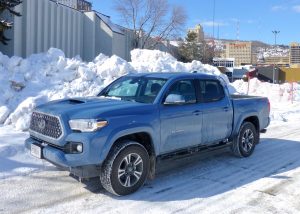
For a midsize truck, Toyota’s Tacoma is big enough for any job, except to see over a Duluth harborside snowpile.
By John Gilbert
We had an interesting coincidence at our home on the North Shore, just outside Duluth, Minn., in January. Our younger son, Jeff, recruited a friend to ride with him so he could drive his brand new Toyota Tacoma pickup truck from Bellingham, Wash., to visit us.
Such a trip in January of 2019 may not seem like a favorable time to be driving through the mountains and challenging Mother Nature in this never-ending winter, but for two young single guys it was an adventure.
His Tacoma is evidence of my long-held suspicion that full-size pickups have gotten bigger and bigger, and midsize pickups — such as the Tacoma — have grown just enough to fill in as perhaps the ideal size for anyone who thinks they need a full-size truck.
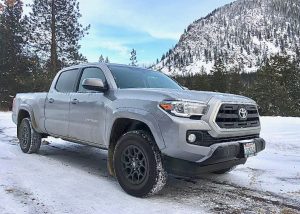
A road-test for real came when Jeff Gilbert drove his personal new truck from the Pacific Northwest to Duluth in January.
Toyota calls it a double cab, whereas you or I might think of it as a crew cab, because it has a full four-door cabin with plenty of room to seat three adults in the rear, and it is powered by a 3.5-liter V6. Jeff said they made good time, driving through Spokane, Coeur d’Alene, Idaho, then Billings and Butte in Montana, and on across North Dakota to Jamestown, Fargo, and on eastward on I-94 to Minneapolis, before heading to Duluth.
They had friends along the way and didn’t run into bad weather until finding the interstate closed and barricaded for drifting snow, necessitating an unscheduled motel stop in Jamestown.
The coincidental part of the story is that three days after Jeff left Minnesota to head home to Washington, my weekly test-drive vehicle arrived, and it was a 2019 Toyota Tacoma TRD Sport 4×4 Double Cab — almost identical to the truck Jeff recently bought from the Bellingham dealership where he works selling cars.
My wife, Joan, and I felt sad when Jeff departed — part of the job description of being parents — but a couple of things helped. For one, I recorded an audio CD for him of the late Guy Clark’s songs, off the “Best of the Dualtone Years” compilations after his death, underscoring Clark’s thought-provoking and clever writing and his outstanding guitar work. Jeff said he enjoyed it enough that he played through the entire double-album about three times before he got to Montana, and he had a lot of other music, too.
Our other idea was we made a deal with him to stay in hands-free phone contact from anywhere he was if he could use some conversation to pass the time, and keep us apprised of his adventure — flying solo, this time. By luck, he was trying to reach his friend’s place to spend his last night on the road in Coeur d’Alene when he got a phone call from a good friend from Bellingham, who had just happened to be on a brief trip to a favorite spot just east of Coeur d’Alene. When he called, Jeff was about an hour from arriving at the same town and his friend said he had already reserved a room for Jeff.
As luck would have it, the only really bad winter storm he encountered either way was coming out of the mountains and leaving Idaho to drive to Spokane. Freezing drizzle and a mountain storm whiteout made him glad he was driving in tandem with his friends as they drove the rest of the way to Bellingham, which is a scenic town about a half-hour from the Canadian border on the way to Vancouver.
We had our own winter-driving challenges around Duluth, and kept our hands firmly on the steering wheel of a 2019 Tacoma that just happened to arrive the day after Jeff left. The Tacoma breezed through the driving part with no flinching, switching its control switch from 2-wheel drive high for clear-pavement commuting, to 4WD automatic, where it could regulate its own selections of how much torque to apportion front and rear. I have to admit to yielding to the temptation of looking for some moderate plowed rows of snow to churn through.
It also was smooth on a trip to Minneapolis and back, for a 5-hour driving day, and the bucket seats and firmly planted stance of the Tacoma won our approval for being considerably more agile and maneuverable than the full-sized pickups of any brand.
Part of the attractiveness of the Tacoma was its exterior color, which was Cavalry Blue, a bright, medium blueish color unique amid all the countless colors available these days. The test Tacoma, being the TRD (for Toyota Racing Division) Sport model means it adds certain trim things, like the black alloy 17-inch wheels, and the sport-tuned suspension.
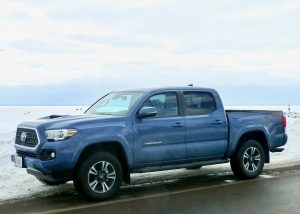
Ice fishermen put up portable fish houses on iced-over Lake Superior, but January was much cozier inside the Tacoma TRD.
Toyota has been revitalizing its engine line, and the Tacoma benefits from having the 3.5-liter V6 which has been recalibrated to deliver 278 horsepower at 6,000 RPMs and 275 foot-pounds of torque, which peaks at 4,800.
The base price of $36,465 climbs quickly to $42,825 with the addition of the TRD Premium Sport and Technology packages. The result is a Tacoma loaded with all the newest convenience and safety features, such as a towing receiver hitch, trailer sway control, sport-tuned shock absorbers, safety sense pre-collision device with pedestrian detection, lane-departure alert, automatic high beams, rear camera with cross-traffic warning, and a large navigation screen with sonar rear parking assist, a cleverly designed fold-down step for getting into the composite-coated bed, which has sliding cleats that can lock in place for tie-downs. That latter feature was first designed by Nissan, and it is one of those good ideas that every competitor tries and fails to beat. Toyota simply copies it. Smart.
The test Tacoma had the 5-foot bed, and a longer one is available, and, Jeff says, makes sense if you want to throw a trail bike in the back with your gear.
Fuel economy was under 20, but we spent a lot of time warming it up against sub-zero cold every day. The ride smoothness of the Tacoma is obviously attributable to the double-wishbone front suspension with coil springs, and the leaf-spring rear suspension with those sport-tuned shocks. The 4×4 capabilities are extracted via a 2-speed electronically controlled transfer case to engage the on-demand part-time 4-wheel drive.
An 8-speed automatic transmission shifts smoothly and gives the Tacoma a sporty feel to its acceleration. All part of the picture, and part of the “preview” test-drive we got from son Jeff’s long drive to visit.
Midsize pickups are making their strongest bid for prominence in years, with the General Motors Colorado and Canyon taking on a new challenger in the Ford Ranger, and we can only wait for Jeep and Hyundai to join Honda with less-than-full-size pickups. Meanwhile, the Toyota Tacoma, which is built in San Antonio, Texas, just keeps expanding its models and defending its claim of being the single vehicle with the best retained value — resale, to you and me — in the industry.
Miata, Beetle Cabrio Don’t Give Up in Winter
Filed under: Weekly test drives, Autos
We’ve been snowed under — literally and figuratively — with a herd of worthy winter vehicles for our road tests on the North Shore of Lake Superior during this harsh winter of 2018-19, but there also were a couple of outrageously unworthy vehicles that were closer to priceless irony than cars that should be challenging 20 below and foot-deep snowstorms.
The pair in question were the Mazda Miata and the Volkswagen Beetle Cabriolet (convertible), both of which are much better suited to summertime warmth, but surprisingly they still made it through separate weeks of commuting in slippery, snow-piled and waybelow-zero conditions.
The 2019 Mazda MX-5, better known as the Miata, is a convertible, but for 2019 it also has a new “targa” model with a power hardtop that drops down into the trunk area when you want top-down driving. I believe that, and you’ll excuse me if I passed up my wife, Joan, and her suggestion that I could bundle up in layers of fleece and down and drive past her while she took my picture. No.
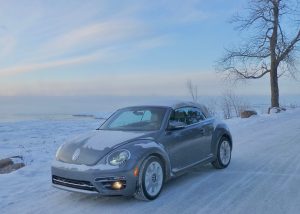
This is the final run of Beetles in Volkswagen’s production plan, and the convertible is winter-worthy.
I’m surprised she didn’t agree to do the air-conditioned driving while I shot the photos. The test part is how the hardtop works on the traditional convertible roadster.
The other vehicle that closely followed the Miata MX-5 was the 2019 Volkswagen Beetle Convertible. The Beetle is heading for its last roundup, as VW has declared it will stop making the car after the current generation runs out. So I got the chance to drive the soft-top Beetle convertible, which is actually more logical as a winter driver than the Miata because at least it has front-wheel drive, being basically a Golf with a Beetle body.
Both of these cars are obviously summertime specialties, but their attraction for derivers of all ages and sizes remains steadfast. And a little harsh winter weather shouldn’t be able to stop that. Read more
Golf SE Conquers 29 Below, Guided by Wolf Moon
Filed under: Weekly test drives, Autos
BEMIDJI, MN.
People in Chicago, or Detroit, or Minneapolis, always nod and say they know what you mean when you say it’s cold in Northern Minnesota. But they don’t. They think “cold” means it was uncomfortably cold, maybe zero, or 10 above, which can be uncomfortable, all right.
Then there’s Bemidji, Minnesota. Paul Bunyan Land, we’re told, and the gigantic statue of Paul and Babe the Blue Ox, which greets you as you enter Bemidji from the south, is their emblem, standing there rigidly on the shores of Lake Bemidji. They are rigid, because it’s 29 below zero outside on this bright and sunny morning in January. Twenty-nine. And we’re not talking wind-chill here, it was minus-29 actual.
Perfect conditions for a test drive of the 2019 Volkswagen Golf SE, a new model to add to the impressive collection of Golf small sedans. We used to be able to say coupes and sedans, but VW decided not to bring even the GTI 2-door to the U.S. this year, so the hot-rod GTI with all its fantastic handling and power comes only as a 4-door.
Of course, there are other Golf models, including the Golf R, which is an all-wheel-drive version of the GTI, and there is the SportWagen, an actual sporty station wagon based on the Golf platform. The Jetta, which began life as a 4-door-with-trunk version of the Golf hatchback, is now separate, although with the same new platform and a unique 1.4-liter turbocharged 4-cylinder at the base of its powertrain. As a group, Motor Trend named the redesigned Golf as its Car of the Year for 2018.
When I heard the vehicle that would be delivered to me in Duluth, Minnesota, would be the new Golf SE, I was more than just interested. After all the big changes for 2018, there were only some minor alterations for 2019, but among them is that VW has taken the 1.4 and put it into two Golf models — the base S and the nicely upgraded SE. Having driven that engine in the Jetta, and being very impressed, it seemed silly that it wasn’t already put into the Golfs, but what did I know?
Well, I knew that as amazingly consistent and strong as the 2.0 and its 1.8 derivative have been over the years, that the 1.4 is from an all-new engine family, and is even more efficient than the redoubtable 1.8 and 2.0.
My wife, Joan, had been planning on driving across to the western end of Minnesota to visit her sister, who was celebrating her birthday in Fergus Falls, so I came up with the ideal compromise. We could drive up Hwy. 2 from Duluth to Bemidji on Friday, stay overnight, and drive south to Fergus Falls on Saturday afternoon, in time to take everybody out to dinner.
The intriguing part of my plan is that the Minnesota Wild and Fox Sports North television have been collaborating for several years on what they call Hockey Day Minnesota. They set up an outdoor rink in a selected town, then they coordinate to spend the whole day putting on return-to-your-roots hockey games between boys and girls high school teams and a couple of college games for good measure, and get the whole thing done in time for the Saturday night Wild game back in the warm confines of Xcel Energy Center in Saint Paul Read more
Sporty Edge ST Features Can Fool You
Filed under: Weekly test drives, Autos
The fellows who carry out the delivery and pickup of test-drive vehicles to auto journalists who drive, evaluate and report on those new cars do an amazingly efficient job, making sure the vehicles are clean, fueled and ready to be driven. But sometimes extenuating circumstances can get in the way.
When I got a 2019 Ford Edge ST for a week, it happened to coincide with what might have been the harshest week in the harshest January winter weather to hit Minnesota in at least a couple of decades. The car washes were all closed up, wisely avoiding the 20-below temperature.
The week was long and cold, with heavy snow accenting the sub-zero plunge, and while none of that prevented me from fully appreciating the Edge’s new sportiest model, I had spent most of the week exploiting all the features and appreciating them greatly as we eased through the endless days of nasty weather.
We appreciated the firm chassis, and the upgraded suspension of the ST, and we also noted almost daily, sometimes more than once a day, how swiftly the seat heaters and heated steering wheel seemed to warm up. Some vehicle have heated seats but it seems like you have to drive 5 miles before you feel any warmth. Not the new Edge. It seemed like 8 or 10 blocks and you were feeling cozy through the seat cushion, which is welcome while you wait for the customary heat buildup.
On that start-up front, we also thoroughly appreciated the auto-start, wherein you remotely lock the doors, then hit the proper button on the key fob and the car starts itself. Good for a brief engine warm-up, and also good for getting a head start on loosening up the glacial deposits on the front and rear windows for a quick clearing.
I was getting a little curious, though, because everything about the Edge ST was so impressive, I wondered if we might find at least a nitpick to balance all the superlatives. We couldn’t complain or praise the “Performance Blue Metallic” exterior paint, because even though our older son, Jack, mentioned what an impressive shade of blue it was, we couldn’t really prove it, located as it was under this weeklong buildup of snow/salt/road-glop that we had not been enjoying.
Finally, the temperature crept up to 15 degrees last Saturday, and I took a chance. Sure enough, the coin-operated car wash on the eastern edge of Duluth, Minnesota, had taken down its boldly lettered “Closed” sign. I pulled in, and nobody else was risking it, so I flung the door up and pulled inside. I had four $1 bills, which was just enough to get you 4 minutes of heavy soap spray, and then a swift rinse to get rid of all that glop. The timer ticks each second off, and a nasty alarm alerts you that you’re in your final minute, and if you’re smart you’ll add more money so that you don’t wind up with a soapy mess when you finish.
All went well, and in my practiced routine, I went in segments to make sure I didn’t miss the left side, front, right side, and rear with the soap wand. Then I quickly switched to rinse and noted I only had 1:30 left. I took care of the left rear corner, then the left side, then the windshield, hood and left front corner. I knew the time was going, and it was going to be close. Got the black-out grille, the foglight and then the right front fender, right side and on back.
Noticing I only had about 30 seconds left, I hustled, and started rinsing the rear hatch. Moving from right to left, I had just reached the far left side when a sudden little noise startled me, and the entire hatch started to flip up. I tried to change hands and push it back down, but it was resisting. I continued around the left rear corner and the water stopped. Out of time.
Hanging up the wand and tubing, I couldn’t resist shooting one photo in the foggy, muggy car wash with the hatch open. Of course, I realized quickly what had happened. The new war of features that Ford has so energetically engaged in has led the company to come up with a slick thing to aid those carrying grocery bags or armloads of luggage to stow, allowing the hatch to release and spring open just by waving your foot under the rear bumper. If you have the key fob in your pocket, the hatch opens. Read more


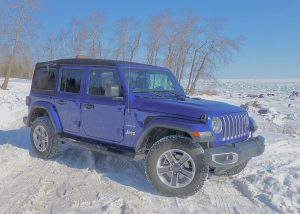
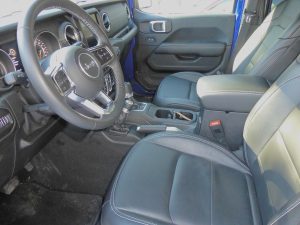
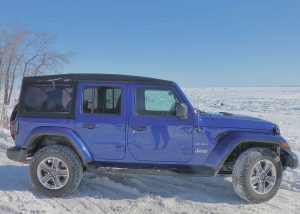
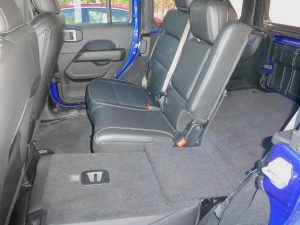
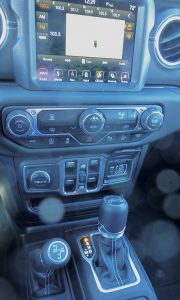
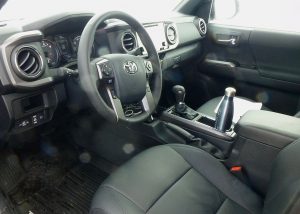
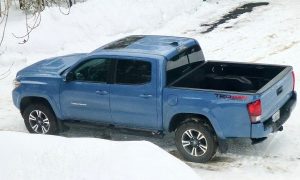
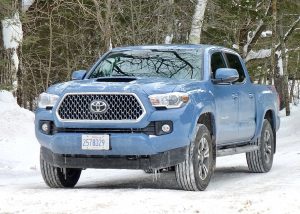
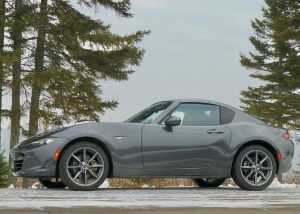
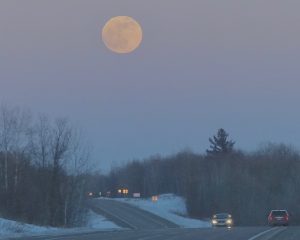
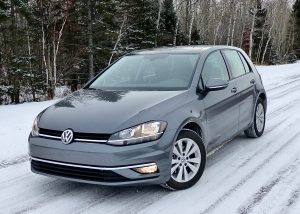
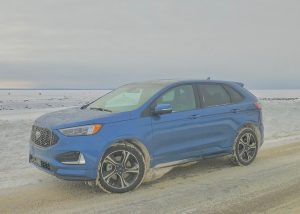
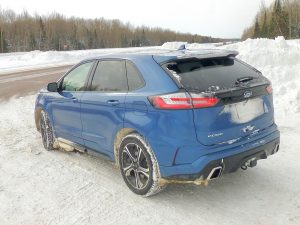
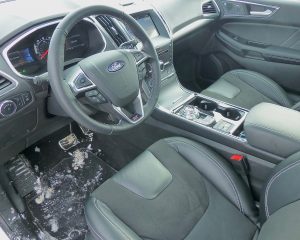
 John Gilbert is a lifetime Minnesotan and career journalist, specializing in cars and sports during and since spending 30 years at the Minneapolis Tribune, now the Star Tribune. More recently, he has continued translating the high-tech world of autos and sharing his passionate insights as a freelance writer/photographer/broadcaster. A member of the prestigious North American Car and Truck of the Year jury since 1993. John can be heard Monday-Friday from 9-11am on 610 KDAL(www.kdal610.com) on the "John Gilbert Show," and writes a column in the Duluth Reader.
John Gilbert is a lifetime Minnesotan and career journalist, specializing in cars and sports during and since spending 30 years at the Minneapolis Tribune, now the Star Tribune. More recently, he has continued translating the high-tech world of autos and sharing his passionate insights as a freelance writer/photographer/broadcaster. A member of the prestigious North American Car and Truck of the Year jury since 1993. John can be heard Monday-Friday from 9-11am on 610 KDAL(www.kdal610.com) on the "John Gilbert Show," and writes a column in the Duluth Reader.